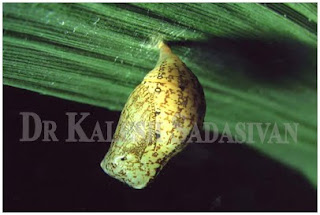Journal of the Bombay Natural History Society, 106(2), May-Aug 2009 142-148
EARLY STAGES OF THE TRAVANCORE EVENING BROWN PARANTIRRHOEA MARSHALLI
WOOD-MASON (SATYRINAE, NYMPHALIDAE, LEPIDOPTERA),
Authors : S. KALESH AND SATYA KRISHNA PRAKASH
Email: kaleshs2002in@yahoo.com
satyaketavarapu@yahoo.co.in
Descriptions of hitherto unknown early stages of the Travancore Evening Brown Parantirrhoea marshalli Wood-
Key words: early stages, endemic species, Travancore Evening Brown, Parantirrhoea marshalli, Satyrinae,
 Travancore Evening Brown Parantirrhoea marshalli
Travancore Evening Brown Parantirrhoea marshallihambu hills. This species could be described
Recently, Kunhikrishnan (2002) reported sightings of this butterfly in the southern region of the Western Ghats. Although both sexes of this butterfly have been photographed, not much information is available on the early stages of this butterfly.
A number of authors have written about the perfect form of this species; but the only mention of its suspected hostplant and early stages are in Fraser (1930), Yates (1931),
 as it was always in its clumps that Yates had found it. Gaonkar (1996) stated that the bamboo Ochlandra
as it was always in its clumps that Yates had found it. Gaonkar (1996) stated that the bamboo Ochlandra
It may be recalled here that Evans (1932) has
It was during overcast evenings that adults were seen flying
We observed that this species
 as it was always in its clumps that Yates had found it. Gaonkar (1996) stated that the bamboo Ochlandra
as it was always in its clumps that Yates had found it. Gaonkar (1996) stated that the bamboo OchlandraIt may be recalled here that Evans (1932) has
It was during overcast evenings that adults were seen flying
We observed that this species
ACKNOWLEDGEMENTS
We are thankful to Krushnamegh Kunte and
REFERENCES
BELL, T.R. (1909): The common butterflies of the plains of India
hill stations of the Bombay
hill stations of the Bombay
ELAMON, S. (1993): Butterflies of Periyar Tiger Reserve. Project Report
submitted to Kerala Forest Department. 50 pp.
submitted to Kerala Forest Department. 50 pp.
EVANS, W.H. (1932): Identifications of Indian Butterflies. 2nd edition,
History Society, Bombay. x + 454 pp., 32 pl.
History Society, Bombay. x + 454 pp., 32 pl.
FERGUSON, H.S. (1891): A list of the Butterflies of Travancore. J. Bombay
FRASER, F.C. (1930): A note on some Malabar Lepidoptera. J. Bombay
GAONKAR, H. (1996): Butterflies of the Western Ghats, India including
A Biodiversity Assessment of a Threatened Mountain
Centre for Ecological Sciences, Indian
A Biodiversity Assessment of a Threatened Mountain
Centre for Ecological Sciences, Indian
KALESH, S. & S.K. PRAKASH (2007): Additions to larval host plants of
104(2): 235-237.
KUNHIKRISHNAN, E. (2002): Diversity of Butterflies in the Neyyar and
KUNTE, K. (2000): Butterflies of Peninsular India. Universities Press
and Indian Academy of Sciences (Bangalore).
and Indian Academy of Sciences (Bangalore).
KUNTE, K. (2006): Additions to known larval host plants of Indian
J. Bombay Nat. Hist. Soc. 103(1): 119-122.
J. Bombay Nat. Hist. Soc. 103(1): 119-122.
KUNTE, K. (2008): Natural history and early stages of the Golden Flitter
(Hesperiidae, Lepidoptera) from the Western
J. Bombay Nat. Hist. Soc. 105(1):
(Hesperiidae, Lepidoptera) from the Western
J. Bombay Nat. Hist. Soc. 105(1):
MARSHALL, G.F.L. & L. DE NICÉVILLE (1883): The Butterflies of India,
Burmah and Ceylon. Vol 1: 261-262. The Calcutta Central Press
Burmah and Ceylon. Vol 1: 261-262. The Calcutta Central Press
SEETHALAKSHMI, K.K. & M.S. MUKTESH KUMAR (1998): Bamboos of
a compendium. Kerala Forest Research Institute and
a compendium. Kerala Forest Research Institute and
WOOD-MASON, J. (1880): Description of Parantirrhoea marshalli, the
Type of new Genus and Species of Rhophalocerous: Lepidoptera
J. Asiat. Soc. Beng. 49(4): 248-250.
Type of new Genus and Species of Rhophalocerous: Lepidoptera
J. Asiat. Soc. Beng. 49(4): 248-250.
WYNTER-BLYTH, M.A. (1957): Butterflies of the Indian Region.
Bombay
Bombay
YATES, J.A. (1931): The Butterflies of Coorg. J. Bombay Nat. Hist. Soc.
Published in Journal of the Bombay Natural History Society, 106(2), May-Aug 2009 142-148




No comments:
Post a Comment